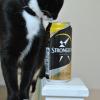No, water does not dissipate heat faster than any other product on the market. It is the radiator that dissipates heat, the coolant merely moves it from one place to another. Funnily enough, the thermal conductivity and the specific heat of the coolant are not the only limiting factors in how much heat is transferred. The efficiency plunges very rapidly as soon as you get DNB at the hot spots in the cylinder head, and that really is influenced by the "wetness" of the coolant. It is a very complex issue, but it is established fact, from aircraft engines, that undiluted glycol is actually better than water in certain cases. There is also massive advantage in using something that prevents a thick film of rust forming in the head and block, as the thermal conductivity of rust is rather poor. That reason alone is why I would consider an exotic coolant, the engine having been designed, when new, to be capable of being cooled by water. Tuning eats into whatever margin the designer left for the effects of rust.

Waterless Coolant
Started by
Carlos W
, Oct 17 2012 07:15 AM
35 replies to this topic
#31

Posted 28 October 2012 - 09:20 PM
#32

Posted 28 October 2012 - 09:36 PM
I can see the use with stopping steam, nucleate boiling is very common in engines and designers are well aware of it and stable nucleate boiling is actually helpful as it agitates the coolant around the hot spots of the engine which helps cool, its when the hot spots become very hot and unstable nucleate boiling occurs and when a layer of steam is produced which will lead to overheating, and 100% glycol systems are now being introduced into modern engines for production cars I think the new ford Ecoboost engines are using it, but they are designed specifically for that, and the a-series was designed for the water glycol mix.
personally I would just stick with a well looked after cooling system, and the standard water/glycol mix, tried and tested and also a lot less expensive!
personally I would just stick with a well looked after cooling system, and the standard water/glycol mix, tried and tested and also a lot less expensive!
#33

Posted 29 October 2012 - 08:47 PM
have done a test at college with water and different mixtures of water/antifreeze. we heated the subjects in a tank then circulated the subject for a set amount of time through an aluminium heat sink. can't remember the exact results and they wasn't far apart but from each other test water released its heat faster than the water/antifreeze mixtures.
#34

Posted 29 October 2012 - 09:32 PM
But you were probably below boiling point, so no DNB at the hot spots. However this is an interesting subject, and it is good to have a variety of opinions. The final arbitrer would be testing several different coolants in the same Mini engine, because although I am fairly certain of what theory says, it does not necessarily allow for the complex geometry and rough cast finish of the waterways in the head and block.
That leads to another interesting possibility, chemically cleaning and polishing the waterways. Obviously you can't get in there, except round the edges, and near the core plugs, to physically clean up the casting.
Anothr hard fact, which is proven in theory and practice, but well nigh impossible to apply to a Mini, is that the best coolants are liquid metals. They only need to be pumped very slowly, and do not need to be pressurised. An electromagnetic pump with no moving parts is possible, basically just a simple motor where the current passes through the molten metal, which reacts against an external permanent magnet. Several nuclear reactors have been cooled by liquid sodium and/or potassium at atmospheric pressure, and the Russian navy used molten lead. Now lead is out for a conventional engine, as the pistons will sieze, amongst other problems, at that sort of temperature. Sodium melts at 97.72C, but with 77% potassium melts at -12.6C, which is potentially useful. It is usual to run the metal through a heat exchanger so that the volume of metal is minimised, the other side of the heat exchanger can be pressurised water, or anything else that is appropriate, as long as the water gets nowhere near the metal. (Explosive reaction!)
There may be other alloys which will flow readily below 100C, and are not explosive. Indium comes to mind, if alloyed with something else to lower the melting point, but it is expensive. There is also mercury of course, far too heavy, and toxic. Might be an interesting experiment!
That leads to another interesting possibility, chemically cleaning and polishing the waterways. Obviously you can't get in there, except round the edges, and near the core plugs, to physically clean up the casting.
Anothr hard fact, which is proven in theory and practice, but well nigh impossible to apply to a Mini, is that the best coolants are liquid metals. They only need to be pumped very slowly, and do not need to be pressurised. An electromagnetic pump with no moving parts is possible, basically just a simple motor where the current passes through the molten metal, which reacts against an external permanent magnet. Several nuclear reactors have been cooled by liquid sodium and/or potassium at atmospheric pressure, and the Russian navy used molten lead. Now lead is out for a conventional engine, as the pistons will sieze, amongst other problems, at that sort of temperature. Sodium melts at 97.72C, but with 77% potassium melts at -12.6C, which is potentially useful. It is usual to run the metal through a heat exchanger so that the volume of metal is minimised, the other side of the heat exchanger can be pressurised water, or anything else that is appropriate, as long as the water gets nowhere near the metal. (Explosive reaction!)
There may be other alloys which will flow readily below 100C, and are not explosive. Indium comes to mind, if alloyed with something else to lower the melting point, but it is expensive. There is also mercury of course, far too heavy, and toxic. Might be an interesting experiment!
#35

Posted 27 November 2012 - 10:49 AM
Is it correct to use deironised water rather than tap?
#36

Posted 27 November 2012 - 12:39 PM
No, water does not dissipate heat faster than any other product on the market. It is the radiator that dissipates heat, the coolant merely moves it from one place to another.
Under this definition, the radiator does not dissipate heat either, it merely moves it from the coolant to the atmosphere!
1 user(s) are reading this topic
0 members, 1 guests, 0 anonymous users
















